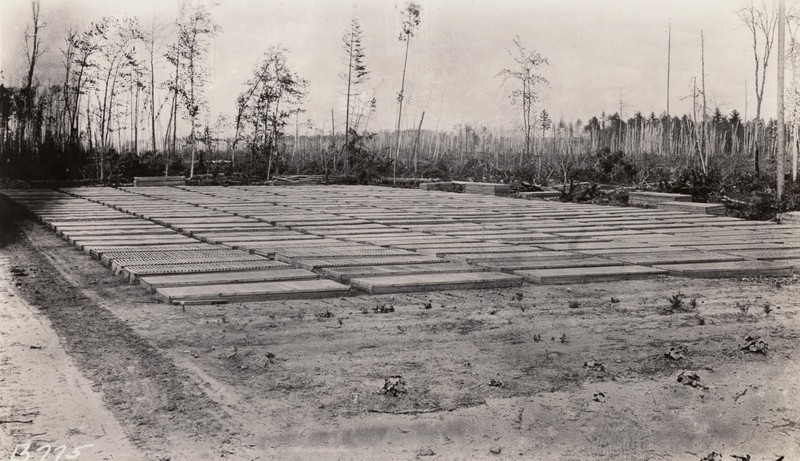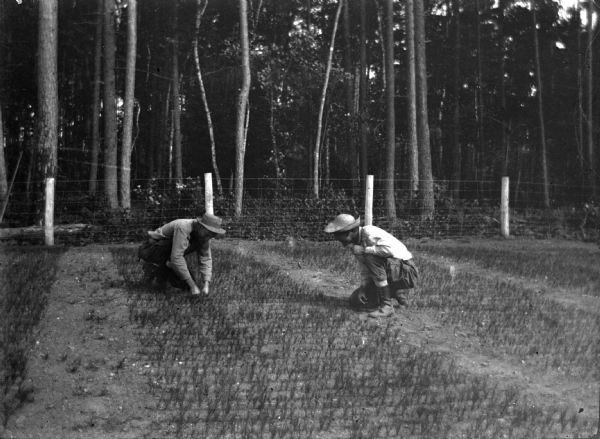Wisconsin's First Tree Nursery
Introduction
Text-to-speech Audio
At the turn of the 20th century, the new Wisconsin Department of Forestry began to reclaim land devastated by the cutover and forest fires. Creating the first state tree nursery became a key part of reestablishing Northwoods forests. Trout Lake in Vilas County was selected for both the State Forestry Headquarters and the state tree nursery. Beginning in 1910, ground was cleared and construction of the nursery began. State Forester E. M. Griffith had a strong sense of urgency to begin replanting and demonstrating how modern forestry practices could rebuild Wisconsin's northern forests.
Importantly, the Trout Lake nursery began to produce a variety of seedlings that were quickly planted by forestry crews. Wisconsin foresters and forest rangers monitored the emerging regrowth, and within a few years, replanting efforts yielded strong results. Over time, other tree nurseries were built across Wisconsin, and theTrout Lake nursery was closed in 1963.
Today, visitors can see the old nursery space by visiting the Trout Lake Ranger Station and walking along the bike trail and Forest Headquarters Road. Please see maps attached below for specifics locations and respect DNR signs regarding access.
Images
Yawkey-Bissell Lumber Camp the railroad spur at North Trout Lake

1911 Trout Lake Nursery

1911 Planting at Trout Lake Nursery

Trout Lake Nursery water tower and plantings

1937 aerial photo of Trout Lake nursery

Trout Lake Nursery management 1958

Trout Lake Nursery reforestation success

C. L. Harrington and Wakeland McNeel planting at Trout Lake Nursery

Clearing land for Trout Lake Nursery

Backstory and Context
Text-to-speech Audio
As State Forester E. M. Griffith began planning reforestation efforts in 1910, land was cleared, and slash was piled and carefully burned on a land tract near the State House. In the spring of 1911, 192,000 seedlings from Michigan Agricultural College (today Michigan State University) were packed and shipped. The Yawkey-Bissell Lumber Company had a logging camp on North Trout Lake and delivered the nursery stock free of charge on the company’s railroad spur that ran right past the new state nursery.
Fast-growing European Scotch pines were selected as the majority species in a bid to more rapidly address reforestation needs. Native seeds were also gathered from remnant stands of slower growing, native white and red pines, supplementing the new nursery. Seed shortages in 1911 required foresters to collect seeds from pine cones to plant native species at the nursery. Young seedlings were protected from the elements with wood slat frames, and once seedlings were harvested, they were preserved in special coolers until they were planted by hand. Mechanical tree planters became available in 1944. The process of running a tree nursery and planting trees to reforest the Northwoods was labor intensive. Head forester Griffith even advertised a special summer camp for those with consumptive or respiratory illness to enjoy the healthy Northwoods climate in exchange for tending the Trout Lake nursery. To Griffith's credit, many Northwoods visitors sought relief from southern heat, humidity and pollution that complicated respiratory diseases.
Bill Barnard was the first head nurseryman at Trout Lake and led an impressive team of budding conservationists who were inspired by Griffith's forestry vision. Importantly, aspiring foresters Neal Harrington and Wakelin McNeel planted some of the first seeds at Trout Lake nursery (photo below). Each of these men would become Wisconsin conservation champions. Harrington was Superintendent of Wisconsin State Forests and Parks from 1923 until his retirement in 1958. As a UW professor, McNeel spread his enthusiasm for learning and love of forestry through his radio show Afield with Ranger Mac, which he launched on Wisconsin Public Radio in 1933. “Ranger Mac” reached an estimated 700,000 elementary students. “Statistics are dull. Kids prefer down-to-earth realism.” – Wakelin “Ranger Mac” McNeel
Trout Lake Nursery was closed in 1963 in favor of of more recently developed southern nurseries, which benefited from longer growing seasons and lower expenses.
Sources
Boulder Junction, The Early Years, Friends of the Library, Boulder Junction, Wisconsin 1996.
“New School of Forestry”, The New North (Rhinelander, Wisconsin). Wednesday, December 18, 1912. page 19
“Pine Is “Coming Back” to Forests of Wisconsin, Leader Telegram (Eau Claire, Wisconsin). Friday, November 22, 1912. Page 6
Chippewa Herald-Telegram (Chippewa Falls, Wisconsin). Wednesday, May 15, 1912. Page 2
Report of the State Forester of Wisconsin. For 1909 to 1910. Madison Wisconsin: Democratic Printing Company, State Printer, 1910.
Report of the State Forester of Wisconsin. For 1911 to 1912. Madison Wisconsin: Democratic Printing Company, State Printer, 1913
Biennial Report of the State Conservation Commission of Wisconsin For the Years 1915-1916. Madison Wisconsin: Cantwell Printing Company, State Printer, 1916.
Biennial Report of the State Conservation Commission of Wisconsin For the Years June, 1917- June 1918. Madison Wisconsin: Democratic Printing Company, State Printer, 1918.
Wilson, F.G. E.M Griffith and the Early Story of Wisconsin Forestry (1903-1915). Department of Natural Resources, Madison WI. 1982,
Ticket to Buswell Railfans: Riding the C. M. & St. P., https://www.facebook.com/groups/449655459814051
DNR UW Madison Digital Collection
DNR UW Madison Digital Collection
DNR UW Madison Digital Collection
Manitowish Waters Historical Society
DNR UW Madison Digital Collection
The Post-Crescent (Appleton, Wisconsin) · 17 Sep 1913, Wed · Page 3
DNR UW Madison Digital Collection
DNR UW Madison Digital Collection
